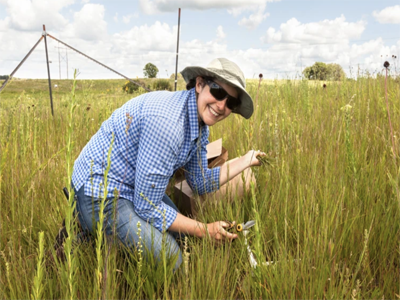
Luis Coloma grew up in Guaranda, Ecuador, a small city in the Andes nestled in a high valley near the Chimborazo volcano. “It was a paradise,” he says. “When I was a kid, the frogs were so abundant it was impossible to ignore them.” Beyond seeing various species living together along the riverbanks, he was elated by their boisterous calls.
In secondary school, Coloma paged through field guides and zoology encyclopedias, eager to find frog species that matched the stunning array of colours, shapes and sizes of the ones in his own back garden — but his searches always came up short. “Looking at these animals that didn’t fit the descriptions was fantastic. It was a world of discovery.”
Inspired by his childhood obsession with amphibians, Coloma moved to the United States in 1988 to pursue a PhD in systematics and ecology at the University of Kansas in Lawrence. But by the time he returned to Ecuador in the late 1990s, the frogs in the mountains where he grew up had already begun to disappear. “It became clear that there were apocalyptic extinctions happening,” he says. “That was the beginning of my conservation work.”
Want to make a difference? Try working at an environmental non-profit organization
In 2021, Coloma co-authored a paper in PLoS ONE stating that 57% of the amphibian species in Ecuador are endangered or vulnerable because of climate change, habitat loss and disease, particularly that caused by Batrachochytrium dendrobatidis, a chytrid fungus1. But declines in biodiversity extend beyond amphibians. Some scientists argue that Earth is entering a sixth mass-extinction event, the first to be caused entirely by the activities of one species — humans. According to the wildlife charity WWF’s Living Planet Report 2022, since 1970 there has been a 69% decline in the average abundance of nearly 32,000 species populations, with the biggest reductions seen in Latin America and the Caribbean. “It’s heartbreaking,” says Coloma, who is now director of the Jambatu Center for Amphibian Research and Conservation in Quito.
Despite the harrowing trends, endangered-species biologists such as Coloma are striving to protect Earth’s biodiversity. But their work with species in danger of extinction brings special challenges — both in handling the organisms and in approaching the daunting odds of success. At times, these efforts can feel like a quixotic battle. Here, endangered-species biologists describe their best strategies for the high-stakes research and how they find reasons for hope.
The weight of a word
One of the major challenges in protecting threatened species is getting them listed as endangered in the first place. Juan Manuel Guayasamín, a biologist at the San Francisco University of Quito, has described 64 amphibian species and 15 reptile species. In 2004, he published a paper describing a new species, the Mache glass frog (Cochranella mache)2. On the basis of his data, he proposed that it should be listed as endangered in the International Union for Conservation of Nature (IUCN) Red List of Threatened Species, a comprehensive source that describes the extinction risk for animals, plants and fungi around the world.
To get a species listed as endangered, researchers must provide adequate data on population sizes, geographic range and extinction probability, which are challenging metrics to estimate when individuals are hard to find and resources are limited. If scientists cannot estimate population size, Guayasamín recommends evaluating whether the species has a small distribution or a reduced or fragmented habitat. “We have more than 600 species of amphibians in Ecuador. It’s impossible to have a monitoring process for every single species — we don’t have enough people or the funds,” says Guayasamín.
But once a species is listed, it can open opportunities for funding and generate broad support. “It’s absolutely worth having species listed as endangered because that’s how you get the public on board with conservation,” says Danya Weber, a conservation biologist and artist in Hilo, Hawaii.

Juan Manuel Guayasamín demonstrates how to handle frogs at a workshop in Colombia.Credit: Pedro Peloso
Biologists often look to national legislation, alongside the IUCN Red List, to protect at-risk species. In 2008, Ecuador became the first country to give nature constitutional rights. It’s still the only country to have such legislation. “It is very unique,” Guayasamín says. “If you can prove that an area at risk has endemic and endangered species, the constitution gives you a lot of strength to take actions to protect it,” such as removing invasive organisms and protecting habitat. Many of the animals described by Guayasamín were key to protecting endangered ecosystems, mostly in the Andes and Chocó ecoregions, under this law.
Try to do no harm
Conservation researchers collect field data on abundance, population trends and threats. They also capture individuals as part of breeding and reintroduction programmes. But their actions can harm not only the species in question, but also the ecosystem. As a result, endangered-species biologists often grapple with the ethical trade-offs between the impacts of interference and the potential consequences of inaction, namely extinction.
“My biggest comfort comes when I start my day,” says Dechen Dorji, who grew up in Bhutan and now directs the WWF’s conservation efforts in Asia from his office in Washington DC. “I’m a Buddhist, and one of our common prayers is a simple verse — may all sentient beings be free from all forms of suffering.”
During his career at the WWF, Dorji has fought to protect Asian elephants (Elephas maximus), tigers (Panthera tigris) and snow leopards (Panthera uncia), as well as lesser-known species such as the musk deer (Moschus spp.), white-bellied heron (Ardea insignis) and ruddy shelduck (Tadorna ferruginea). Although a better understanding of these animals can improve conservation outcomes, it’s crucial to do research in a way that limits negative impacts, he says. For instance, Dorji and his team have trapped tigers to fit them with GPS tracking collars to study their ecology and movements, but the trapping process can injure the tigers’ limbs. “Humane treatment of tigers, careful planning and continuous monitoring are essential to minimize the risks of injury,” Dorji says.

Conservation biologist Danya Weber helps connect people to species through her artwork.Credit: Mahina Choy
To reduce their impacts, Dorji and his colleagues also sample environmental DNA, genetic material shed by organisms that is found in soil, water, faeces and other sources, to non-invasively track the presence of different species in a habitat. “It’s cost effective, accurate and we can detect a whole range of species without causing any harm,” he says.
In the Pacific Ocean, Jordan Lerma, a field biologist at Cascadia Research Collective, who is based in Hilo, uses another hands-off approach. As of 2021, the endangered and declining Main Hawaiian Islands population of false killer whales (Pseudorca crassidens) has about 138 individuals. Cascadia researchers want to study their habitat use, abundance, growth, movement patterns and threats. “They are really difficult to find, and once we find them, they don’t want to be around us,” says Lerma. In 2014, to lessen the impacts of boat-based research, Lerma started flying drones over whales and dolphins in Hawaiian waters. Although drones can’t entirely replace hands-on methods, using minimally invasive sampling techniques when possible reduces the number of direct human interactions with animals and provides effective ways to collect biological data.
For other researchers, the downsides of studying endangered species in the wild drive them to find alternative ways to protect the animals. Weber started her scientific career in 2016 as a conservation technician at the Kaua‘i Forest Bird Recovery Project, a non-profit organization in Hanapepe, Hawaii, that works to conserve three federally endangered bird species, including the songbirds ‘akikiki (Oreomystis bairdi) and ‘akeke‘e (Loxops caeruleirostris). For the next two years, Weber wandered the forests in search of bird nests to monitor populations and collect eggs for captive breeding. “In Hawaii, we don’t have any native land mammals that walk around in the forest trampling vegetation,” she says. The only large creatures that do so are humans. “When we’re doing conservation work, we’re creating all these little routes for erosion.”
How we packed off the giant pandas from the Smithsonian’s National Zoo
Other protection efforts that involve the use of herbicides to remove invasive plant species can negatively affect native plants and soil microbes, Weber adds. “It’s easy to get laser-focused on the particular endangered species that you’re working with and not take into consideration our impacts on everything else in the area.”
In 2017, Weber founded Laulima, a fashion and art store that seeks to connect people with and preserve Hawaii’s native biodiversity through merchandise, including apparel, accessories, stickers and mugs designed by Weber and other artists. “With my artwork, I help people build relationships with these plants and animals they share a home with, since many people will never get the opportunity to visit pristine native forests,” she says. Every product comes with packaging that educates the buyer about the species in the design.
“The literal translation of laulima is ‘many hands’,” Weber says. “To protect native species, we need all hands on deck.” Many of Weber’s watercolours and digital illustrations are inspired by species that have political or social relevance. For example, Hawaii’s governor designated 2023 as the year of the kāhuli, so her artwork highlighted these native Hawaiian snails (Achatinella spp.). Weber also raises awareness about endangered Hawaiian monk seals (Monachus schauinslandi), some of which have been killed by humans who mistakenly think the seals are not native and are competing with local fishers for food.
For Weber, pursuing a career in conservation art and outreach has been worthwhile. “When I was in the field, it felt like an uphill battle. It’s very hard to see the fruits of your labour. Whereas in outreach, you see people’s mindsets shift. I’ve noticed a lot more teenagers and university-age students getting into careers in conservation.”
Banding together
Perhaps the biggest challenge of endangered-species work is facing the fact that they might soon disappear. “The more you know, the sadder it gets, unfortunately,” says Lerma. And yet, Lerma and others maintain glimmers of hope and continue fighting for protections. For Weber, cracking sarcastic jokes with colleagues about being underfunded and battling invasive species can help to ease the heaviness. Guayasamín leans into his strong sense of moral responsibility: “Many species are in danger because of human activity, so it’s our responsibility to respect nature and address our impacts.”
Building collaborations that extend beyond the scientific realm is another way for scientists to find inspiration and camaraderie. In April in Paro, Bhutan, Dorji attended the Sustainable Finance for Tiger Landscapes Conference, which kick-started an effort aiming to raise US$1 billion by 2034 to spend on the conservation of tigers and the landscapes where they live. More than 200 people from around the world attended, including private donors, government leaders and members of financial institutions. “To see that partnership, commitment and sense of urgency was hugely exciting,” says Dorji. “Those kinds of things keep us going.”

Dorchen Dorji, who grew up in the Himalayan mountains in Bhutan and now oversees the WWF’s conservation efforts in Asia, says collaborating with local community members is essential.Credit: Dechen Dorji/WWF
In January 2023, Lerma founded Nēnē Research and Conservation, an organization that partners with government agencies and community groups to protect the nēnē (Branta sandvicensis), a goose species that is endemic to Hawaii. Nēnē were federally down-listed from endangered to threatened in 2019, thanks to successful conservation efforts that brought the population from 30 individuals in the 1950s up to more than 3,800 in 2022. But the species is still listed as endangered at the state level.
Over the past year, Lerma and his team have launched a database in which community members record nēnē sightings, injuries and deaths. Nēnē tend to gather in areas frequented by people, such as golf courses and parks, so they’re easy to find.
Lerma’s team used this database, which now has 1,055 contributors and 11,723 sightings, to identify a stretch of road on the Big Island where many nēnē were hit by cars. “We presented that data to the county and got speed tables and raised crosswalks installed. We’re protecting the community and the species. No nēnē have been killed since.”
Dorji also emphasizes the importance of collaborating with local and Indigenous communities whose efforts and lands play an essential part in conservation, he says. “We often tell conservation stories from a very utilitarian perspective of how beneficial other species are to humans, but many cultures have their own stories that we need to listen to and respect.”
I took my case to Nepal’s highest court to improve conservation
In many cases, community members uniquely understand the ecology and biology of local flora and fauna. At the Jambatu Center for Amphibian Research and Conservation, Coloma and his colleagues maintain colonies of about 2,600 individuals of 76 amphibian species, including 30 that are close to extinction. He attributes the success of these programmes to two staff members who were born in the jungles of Ecuador. “They are not PhDs. They are people that love these animals and have a specialized understanding of their needs,” he says.
In 2016, Coloma heard about the presence of a jambato toad (Atelopus ignescens) from a priest in Angamarca, Ecuador. “The jambato were part of the daily life of the Indigenous people here; they used them as a medicine, and they were part of kids’ games in the Andes,” says Coloma. But the once-abundant species hadn’t been seen since March 1988 and was declared extinct by the IUCN in 2004.
When the priest sent Coloma a photo of the toad, which was found by a ten-year-old boy on the child’s family’s farm, Coloma was stunned. “I couldn’t believe it. I lost the faith that I would see these frogs again. It was a dream,” he says. The species was re-listed as critically endangered in 2016. Now, Coloma’s organization is searching for more jambato toads in the wild and breeding them in captivity, with the hopes of reintroducing them in future. “We need to fight for our dreams.”
Source link







